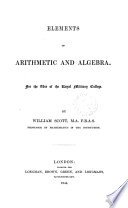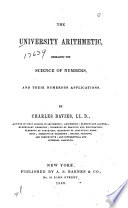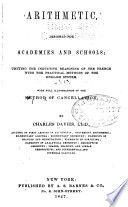 That is, the last term of a geometrical progression is equal to the first term multiplied by the ratio raised to a power whose exponent is one less than the number of terms. That is, the last term of a geometrical progression is equal to the first term multiplied by the ratio raised to a power whose exponent is one less than the number of terms.  Elements of Algebra - Page 1901839 - 355 pagesFull view Elements of Algebra - Page 1901839 - 355 pagesFull view - About this book
 | William Scott - Algebra - 1844 - 568 pages
...the exponent of q in any term is indicated by the number of preceding terms, and any term whatever is equal to the first term multiplied by the ratio raised to a power marked by the number of the terms which precede the term proposed. The formula l=aq~~l 1 is called... | |
 | Charles Davies - Algebra - 1845 - 382 pages
...n — 1 terms before it, is expressed by arn~l. Let I be this -term; we have the formula I = arn~\ by means of which we can obtain any term without being...obliged to find all the terms which precede it. That is, Any term of a geometrical progression is equal to the first term multiplied by the ratio raised to... | |
 | Elias Loomis - Algebra - 1846 - 376 pages
...in the third term is 2, in the fourth term 3, and so on ; hence the nth term of the series will be That is, The last term of a geometrical progression is equal to the product of the first term by that power of the ratio whose index is one less than the number of terms.... | |
 | Elias Loomis - Algebra - 1846 - 380 pages
...series will be Hence, putting I for the last term, and n the number of terms of the series, we obtain That is, The. last term of a geometrical progression is equal to the product if the first term by that power of the ratio whose index is one less than the number of terms.... | |
 | Frederic A. Adams - Arithmetic - 1846 - 230 pages
...the fourth term is 2X33, or the first term X the third power of the ratio. Thus each term consists of the first term multiplied by the ratio, raised to a power whose index is one less than the number expressing the place of the term. 1. What is the 7th term in the... | |
 | Charles Davies - Arithmetic - 1846 - 378 pages
...x 2 = 2*, 2 x 2 x 2 = 23, and 2 x 2 x 2 x 2 = 2". Therefore, any term of the progression is ecyjal to the first term multiplied by the ratio raised to a power 1 less than the number of the term. CASE I. Having given the first term, the common ratio, and the... | |
 | Charles Davies - Arithmetic - 1847 - 368 pages
...term, &c. for the other terms. But 2x2 = 22, 2x2x2-= 23, and 2x2x2x2=24. Therefore, any term of the progression is equal to the first term multiplied by the ratio raised to a power 1 less than the number of the term. CASE I. Having given the first term, the common ratio, and the... | |
 | Charles Davies - Algebra - 1848 - 302 pages
...has n—\ terms before it, is expressed by aq"~}. Let I be this term ; we then have the formula hv means of which we can obtain any term without being obliged to find all the terms which precede it. Hence, to find the last term of a progression, we have the following RULE. I. Raise the ratio to a... | |
 | Charles Davies - Algebra - 1848 - 300 pages
...which has n— 1 terms before it, is expressed by aq"-1. Let / be this term ; we then have the formula by means of which we can obtain any term without being obliged to find all the terras which precede it. Hence, to find the last term of a progression, we have the following RULE.... | |
 | Charles Davies - Algebra - 1850 - 292 pages
...— 1 terms before it, is expressed by aqn~l. Let I be this term ; we then have the formula l=aqn~\ by means of which we can obtain any term without being obliged to find all the terms which precede it. Hence, to find the last term of a progression, we have the following RULE. I. Raise the ratio to a... | |
| |